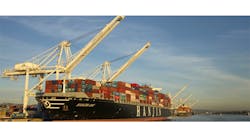Cargo volume at the nation’s major retail container ports is expected to continue to rise during most of the first half of 2015 despite significant congestion still impacting West Coast ports, according to a study by the National Retail Federation and Hackett Associates.
2014 started out with a whimper as winter weather hammered the country but it appears to have ended with a bang,” Hackett Associates founder Ben Hackett says. “Import volumes on the West Coast, despite all the problems there, were the highest since 2009. A similar picture exists on the East Coast, which had even healthier results.”
Ports covered by the report handled 1.39 million twenty-foot equivalent units (TEUs) in November, the latest month for which after-the-fact numbers are available. That was down 10.7% from October as holiday merchandise wound down but up 3.5% from November 2013. December was estimated at 1.35 million TEUs, up 2.7% from the year before.
Those numbers brought 2014 to a preliminary total of 17.2 million TEUs, an increase of 6% over 2013’s 16.2 million. Imports in 2012 totaled 15.8 million. January is forecast at 1.39 million TEUs, up 1.1% from January 2014, February at 1.3 million TEUs, up 4.8% from last year; March also at 1.3 million TEUs, down 0.5%; April at 1.43 million TEUs, the same as last year; and May at 1.49 million TEUs, up 0.6%.
These results were achieved during major congestion issues on the West Coast. The contract between the Pacific Maritime Association and the International Longshore and Warehouse Union expired on July 1. The lack of a contract and other operational issues led to crisis-level congestion at the ports, and NRF asked President Obama to engage with the parties and encourage the use of a federal mediator. A mediator arrived in San Francisco on Tuesday and is currently working with labor and management on the contract negotiations.
“The urgent need to end the uncertainty we’ve seen for half a year now isn’t over just because the holiday season has ended,” says Jonathan Gold, NRF vice president for Supply Chain and Customs Policy. “Retailers are already starting to bring in products for the spring season, and want both labor and management to work together to bring these issues to an end.”



